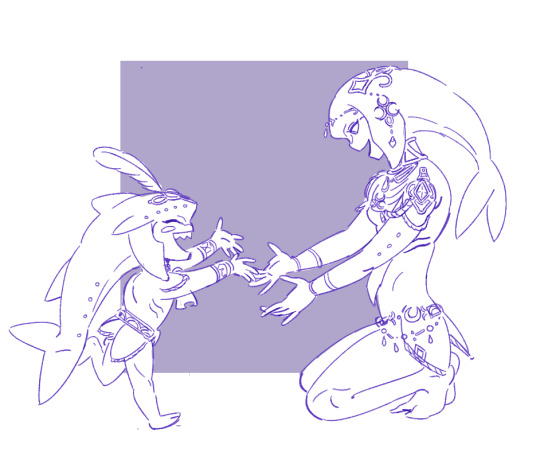#dimorphism
Text



By: Daisy Stephens
Published: Jul 24, 2022
The Black Trowel Collective, a group of American archaeologists, claimed there are suggestions that many historical cultures had more than two genders and so archaeologists should be "wary of projecting our modern sex and gender identity categories onto past individuals".
The group claimed scientists have a "long history of imposing modern patriarchal gender and sexual norms onto the past".
"Human gender is highly variable and... human beings have historically been comfortable with a range of genders beyond modern 'masculine' and 'feminine' binaries," the group wrote in a blog post.
The Daily Mail claims that some academics are beginning to label ancient human skeletons as 'non-binary' or 'gender neutral'.
The idea has been criticised by historian Jeremy Black, who said gender is key to understanding history.
"It is an absurd proposition as the difference between genders, just as the difference between religious, social and national groups, are key motors in history," he told the Daily Mail.
"This very ideological approach to knowledge means that we're in danger of making knowledge itself simply a matter of political preference."

==
Life continues to imitate parody. 🤡
"projecting our modern sex and gender identity categories onto past individuals"
Current gender woo is the invention and imposition of bored, modern first-world academic elites, which makes this absurdly ironic.
"we're in danger of making knowledge itself simply a matter of political preference."
This is literally the postmodern, social constructivist belief and objective.
No one ever needs to respond to this deranged ideology with anything other than "no."
#Titania McGrath#Stephen Knight#anti science#antiscience#science denial#biological sex#biological reality#biological dimorphism#dimorphism#gender ideology#queer theory#social constructivism#social construct#gender pseudoscience#gender activism#woke activism#wokeness as religion#wokeism#cult of woke#woke#religion is a mental illness
963 notes
·
View notes
Text

Can yo- can y- can you guys guess which one is the girl cat. I have no idea. They should've made it more obvious I think .
20 notes
·
View notes
Text
My Ideal Shipping Dynamic

It’s valentine’s day here in Indonesia, and I have no shipping art unfortunately... but here, have a shipping dynamic!
#shipping dynamics#monster#creature design#dimorphism#character design#artists on tumblr#my art#nazrigart#kaiju
139 notes
·
View notes
Note
Are Nidoking and Nidoqueen actually different species?
No, they are of the same species.
They are all of the same evolutionary line. It's just Sexual Dimorphism.
This is when male and females of a species have different appearances and even characteristics at maturity.
Pyroar has this in its male and female forms, Unpheasant as well, with the males being much more show-off and put on displays with their bright colors.
The Nidoran line is very unique as the dimorphism is pretty drastic in their final forms to the point where their 2nd and final forms are classified differently.
It's just how their line grows, and that isn't to say that there aren't more aggressive and bulkier Nidoqueens and much smaller and more docile Nidokings.
To sum it up, no, they aren't different species. They are just a prime example of how drastic dimorphism can be in a species line, and you should look for any other differences in species.

#ranger rai#pokemon ranger#the ranger base#pokemon#ask me anything#ask me a question#nidoran#nidoqueen#nidoking#Dimorphism#gender differences#pokemon facts#the studies on this topic are really interesting#but some of the researchers are weird#i dont wanna talk aboit it
14 notes
·
View notes
Text
If you use the term "partner" to discuss a person with whom you are in a relationship, you are sending the message that you either disdain human sexual dimorphism or the institution of marriage.
So I disdain your opinions.
6 notes
·
View notes
Text
Today my family went to a mineralogical museum. It's an awesome place (so many pretty rocks!), but one thing made me chuckle, namely this poster:

This is supposed to be the Mistress of the Copper Mountain, a folklore lady with powers over gems and ores who is known to appear as a lizard with a crown. But here is a catch: this is a male lizard.
As I mentioned in one of my photosets, males of this species turn green during mating season, while females always stay the “standard” gray-brown colour. Meaning, if you see a green lizard that looks like this, it is a horny boy. So to me this picture has the same energy as decorations (for Easter and the like) that depict roosters sitting on eggs or taking care of chicks, because people who were asleep when their biology teacher explained sexual dimorphism think hens aren't marketable pretty enough.
#dimorphism#trans rights#(accidental)#or maybe the mistress is just genderfluid#good for them#random trivia
3 notes
·
View notes
Text
Birds can see colors because they have rods and cones, sensory cells in the retina that transmit information to the optic nerve and brain. Rods detect black and white and are most numerous in nocturnal birds, whereas cones perceive color. Humans have three cones, detecting red, green, and blue. Birds have these cones, too, but they see more shades of color because their range is more evenly distributed across the spectrum. Birds also possess oil droplets in their cone cells that enhance the perception of color and sharpen vision by reducing glare, like polarized sunglasses. So our usual assessment of plumage color—red cardinals and pink flamingoes—is fine for describing birds, but may not reflect what birds see. Along with red, green, and blue, birds have a fourth color receptor capable of perceiving ultraviolet (UV, “above violet”)—the spectrum of light radiation that has a shorter wavelength but higher frequency and energy than visible light.
One study on monomorphic birds (those whose sex we cannot distinguish) used instruments that measured UV reflectance and indicated that more than 90 percent of birds whose sexes appear identical to us are actually sexually dichromatic to the birds themselves. Another interesting study investigated the response of territory-holding Yellow-breasted Chats to an artificial model. Even though the sexes of the chat look identical to us, the territory-holding birds responded with sex-appropriate behaviors to the models, depending on whether they were made of female or male feathers. The only clue they could have responded to was some aspect of plumage colors such as UV reflectance.
1 note
·
View note
Text
Sexual dimorphism of the brain
It's a stablished fact that the female and male brain are morphollogically different, although it's not completely clear which mechanisms determines which differences and to which extent. For example, one could argue that the mean differences in size are due to the mean differences in general body size, but in other cases it's clear that some of endogenous and sex-related mechanism are responsible. For example, estradiol downregulates the activity of the COx 1 and 2 enzymes, which in turns reduces the synthesis of Prostaglandin E2 (PGE2). This is specially important in the mPOA of the hypothalamus, because high concentrations of PGE2 stymulates dendritic growth, leading to a male structure, and the basal unstymulated mPOA is characterystically female.
Other mechanism may be genetic, for example, the Sry gene found exlusively in the Y chromosome is critical in the process of brain masculinization (again, female is the default), so the absence or mutation of that gene results in a female brain morphollogy, regardless of XY chariotype and hormonal status. But, if the Sry gene is translocated to the X chromosome, this results in the entire masculinization of the body, not just the brain, in XX chariotype. So it's interesting that the gene functions differently in different chromosomes, I'm curiose what would be the effect of having the Sry gene in both X and Y chromosomes in a XY person.
That being said, we must be cautious with biological determinism, that I see poping up in transphobe arguments, because, even when we know for certain that there are differences, and some differences can be explain by genetic or hormonal factors, other differences may be better explained as the effects of the differential socialization between AMAB and AFAB people. For example, there was a experiment in kittens, were they close one of it's eyes during their critical period of brain plasticity, then they opened the closed lid. They finded that, even in the absence of biological alterations, the occipital lobe that were in charge of the closed eye was underdeveloped, and the difference was so drastic that the cats remained blind of that otherwise healthy eye.
So, what I´m saying is that, environmental factors, especially socialization in a especies so intrinsically interdependent as us humans, can have a drastic effect on brain morphollogy during the critical years of development. I believe this to be the case in the language areas of the brain, larger in females than in males, that the difference is due to gender norms, we stimulate more the language and interpersonal abilities in girls, so the brain response is to enhance the areas that allows it to better perform in this environment.
In conclusion, it's necessary to acknowledge the fact of the difference between the female and male brain, but beware those who use that difference to impose gender norms unto us. This is not set in stone, and as humans we are much, much more that only body parts and complex chemistry.
Love to y'all, regardless of your brain type.
Source:
-Rezzani, R. ; Franco, C. & Rodella, L.R. (2019). Sex differences of the brain and their implications for personalized therapy. Pharmacological research (2019) 429-442
0 notes
Text
By: Robert Lynch
Published: April 7, 2023
In my first year of graduate school at Rutgers, I attended a colloquium designed to forge connections between the cultural and biological wings of the anthropology department. It was the early 2000s, and anthropology departments across the country were splitting across disciplinary lines. These lectures would be a last, and ultimately futile, attempt to build interdisciplinary links between these increasingly hostile factions at Rutgers; it was like trying to establish common research goals for the math and art departments.
This time, it was the turn of the biological anthropologists, and the primatologist Ryne Palombit was giving a lecture for which he was uniquely qualified — infanticide in Chacma baboons. Much of the talk was devoted to sex differences in baboon behavior and when it was time for questions the hand of the chair of the department, a cultural anthropologist, shot up and demanded to know “What exactly do you mean by these so-called males and females?” I didn’t know it at the time but looking back I see that this was the beginning of a broad anti-science movement that has enveloped nearly all the social sciences and distorted public understanding of basic biology. The assumption that sex is an arbitrary category is no longer confined to the backwaters of cultural anthropology departments, and the willful ignorance of what sex is has permeated both academia and public discussion of the topic.
Male and female are not capricious categories imposed by scientists on the natural world, but rather refer to fundamental distinctions deeply rooted in evolution. The biological definition of males and females rests on the size of the sex cells, termed gametes, that they produce. Males produce large numbers of small gametes, while females produce fewer, larger ones. In animals, this means that males produce lots of tiny sperm (between 200 and 500 million sperm in humans) while females produce far fewer, but much larger, eggs called ova (women have a lifetime supply of around 400). Whenever scientists discover a new sexually reproducing species, gamete size is what they use to distinguish between the males and the females.
Although this asymmetry in gamete size may not seem that significant, it is. And it leads to a cascade of evolutionary effects that often results in fundamentally different developmental (and even behavioral) trajectories for the two respective sexes. Whether you call the two groups A and B, Big and Little, or Male and Female, this foundational cell-sized difference in gamete size has profound effects on evolution, morphology, and behavior. Sexual reproduction that involves the union of gametes of different sizes is termed anisogamy, and it sets the stage for characteristic, and frequently stereotypical, differences between males and females.
My PhD advisor, the evolutionary biologist Robert Trivers, was at that doomed colloquium at Rutgers. It was Trivers, who four decades earlier as a graduate student at Harvard, laid down the basic evolutionary argument in one of the most cited papers in biology. Throwing down the gauntlet and explaining something that had puzzled biologists since Darwin, he wrote, “What governs the operation of sexual selection is the relative parental investment of the sexes in their offspring.” In a single legendary stroke of insight, which he later described in biblical terms (“the scales fell from my eyes”), he revolutionized the field and provided a broad framework for understanding the emergence of sex differences across all sexually reproducing species.
Because males produce millions of sperm cells quickly and cheaply, the main factor limiting their evolutionary success lies in their ability to attract females. Meanwhile, the primary bottleneck for females, who, in humans, spend an additional nine months carrying the baby, is access to resources. The most successful males, such as Genghis Khan who is likely to have had more than 16 million direct male descendants, can invest relatively little and let the chips fall where they may, while the most successful women are restricted by the length of their pregnancy. Trivers’ genius, however, was in extracting the more general argument from these observations.
By replacing “female” with “the sex that invests more in its offspring,” he made one of the most falsifiable predictions in evolution — the sex that invests more in its offspring will be more selective when choosing a mate while the sex that invests less will compete over access to mates. That insight not only explains the rule, but it also explains the exceptions to it. Because of the initial disparity in investment (i.e., gamete size) females will usually be more selective in choosing mates. However, that trajectory can be reversed under certain conditions, and sometimes the male of a species will invest more in offspring and so be choosier.
When these so-called sex role reversals occur, such as in seahorses where the males “get pregnant” by having the female transfer her fertilized eggs into a structure termed the male’s brood pouch and hence becoming more invested in their offspring, it is the females who are larger and compete over mates, while the males are more selective. Find a species where the sex that invests less in offspring is choosier, and the theory will be disproven.
The assertion that male and female are arbitrary classifications is false on every level. Not only does it confuse primary sexual characteristics (i.e., the reproductive organs) which are unambiguously male or female at birth 99.8 percent of the time with secondary sexual characteristics (e.g., more hair on the faces of men or larger breasts in women), it ignores the very definition of biological sex — men produce many small sex cells termed sperm while women produce fewer large sex cells termed eggs. Although much is sometimes made of the fact that sex differences in body size, hormonal profiles, behavior, and lots of other traits vary across species, that these differences are minimal or non-existent in some species, or that a small percentage of individuals, due to disorders of development, possess an anomalous mix of female and male traits, that does not undermine this basic distinction. There is no third sex. Sex is, by definition, binary.
In the 50 years since Trivers’ epiphany, much has tried to obscure his crucial insight. As biology enters a golden age, with daily advances in genotyping transforming our understanding of evolution and medicine, the social sciences have taken a vastly different direction. Many are now openly hostile to findings outside their narrow field, walling off their respective disciplines from biological knowledge. Why bother learning about new findings in genetics or incorporating discoveries from other fields, if you can assert that all such findings are, by definition, sexist?
Prior to 1955, gender was almost exclusively used to refer to grammatical categories (e.g., masculine and feminine nouns in French). A major shift occurred in the 1960s when the word gender has been applied to distinguish social/cultural differences from biological differences (sex). Harvard Biologist, David Haig documented that from 1988 to 1999 the ratio of the use of “sex” versus “gender” in scientific journals shrank from 10 to 1 to less than 2 to 1, and that after 1988 gender outnumbered sex in all social science journals. The last twenty years have seen a rapid acceleration in this trend, and today this distinction is rarely observed. Indeed, the biological concept of sex in reference to humans has become largely taboo outside of journals that focus on evolution. Many, however, are not content with limiting the gender concept to humans and a new policy instituted by all Nature journals requires that manuscripts include a discussion of how gender was considered in all studies with human participants, on other vertebrates, or on cell lines. When would including gender be appropriate in a genetic study of fruit flies?
This change is not merely stylistic. Rather, it is part of a much larger cultural and political movement that denies or attempts to explain away the effects of biology and evolution in humans altogether. The prevailing dominant view in the social sciences is that human sex differences are entirely socially constructed. In that interpretation, all differential outcomes between men and women are the result of unequal social, economic, and political conditions, and so we do all we can to eliminate them, particularly by changing our expectations and encouraging gender-neutral play in children. This received wisdom and policies based upon it, however, are unlikely to produce the results proponents long for. Why is that?
Because sex differences in behavior are among the strongest effect sizes in social, and what might be better termed, behavioral sciences. Humans are notoriously inept at understanding differences between continuous variables, so it is first useful to define precisely what “statistical differences between men and women” does and does not mean. Although gamete size and the reproductive organs in humans are either male or female at birth in over 99 percent of cases, many secondary sexual characteristics such as differences in upper body strength and differences in behavior are not so differentially distributed. Rather, there is considerable overlap between men and women. Life scientists often use something called the effect size as a way to determine if any observed differences are large (and therefore consequential) or so small as to be ignored for almost all practical purposes.

Conceptually, the effect size is a statistical method for comparing any two groups to see how substantially different they are. Graphically, it can be thought of as the distance between the peaks of the two distributions divided by the width of those distributions. For example, men are on average about 6 inches taller than women in the United States (mean height for American women is 5 feet 3 inches and the mean height for American men is approximately 5 feet 9 inches). The spread of the height distributions for men and women, also known as the standard deviations, are also somewhat different, and this is slightly higher for men at 2.9 inches vs 2.8 inches for women. For traits such as height that are normally distributed (that is, they fit the familiar bell curve shape), one standard deviation on either side of the mean encompasses about 68 percent of the distribution, while two standard deviations on either side of the mean encompass 95 percent of the total distribution. In other words, 68 percent of women will be between 60.2 inches and 65.8 inches tall, and 95 percent will be between 57.5 to 68.6 inches. So, in a random sample of 1000 adult women in the U.S., approximately 50 of them will be taller than the average man (see figure above).
A large effect size, or the standardized mean difference, is anything over 0.8 and is usually seen as an effect that most people would notice without using a calculator. The effect size for sex differences in height is approximately 1.9. This is considered to be a pretty big effect size. But it is certainly not binary, and there are lots of taller-than-average women who are taller than lots of shorter-than-average men (see overlap area in figure). Therefore, when determining whether an effect is small or large, it is important to remember that the cutoffs are always to some degree arbitrary and that what might seem like small differences between the means can become magnified when comparing the number of cases that fall in the extremes of (the tails of their respective distributions) of each group.
In other words, men and women may, on average, be quite similar on a given trait but will be quite different in the number who fall at the extreme (low and high) ends of their respective distributions. This is particularly true of sex differences because natural selection acts more strongly on men, and males have had higher reproductive variance than females over our evolutionary history. That is to say that a greater number of men than women have left no descendants, while a very few men have left far more. Both the maximum number of eggs that a woman produces over the course of her reproductive life versus the number of sperm a man produces and the length of pregnancy, during which another reproduction cannot occur, place an upper limit on the number of offspring women can have. What this means is that males often have wider distributions for a trait (i.e., more at the low end and more at the high end) so that sex differences can be magnified at the tail ends of the distribution. In practical terms, this means that when comparing men and women, it is also important to look at the tails of their respective distributions (e.g., the extremes in mental ability).
The strongest effect sizes where men tend to have the advantage are in physical abilities such as throwing distance or speed, spatial relations tasks, and some social behaviors such as assertiveness. Women, meanwhile, tend to have an edge in verbal ability, social cognition, and in being more extroverted, trusting, and nurturing. Some of the largest sex differences, however, are in human mate choice and behaviors that emerge out of the evolutionary logic of Trivers’ parental investment theory. In study after study, women are found to give more weight to traits in partners that signal an ability to acquire resources, such as socioeconomic status and ambition, while men tend to give more weight to traits that signal fertility, such as youth and attractiveness.
Indeed these attitudes are also revealed in behavior such as age at marriage (men are on average older than women in every country on earth), frequency of masturbation, indulging in pornography, and paying for sex. Although these results are often dismissed, largely on ideological grounds, the science is rarely challenged, and the data suggest some biological difference (which may be amplified, indeed enshrined, by social practices).
The evidence that many sex differences in behavior have a biological origin is powerful. There are three primary ways that scientists use to determine whether a trait is rooted in biology or not. The first is if the same pattern is seen across cultures. This is because the likelihood that a particular characteristic, such as husbands being older than their wives, is culturally determined declines every time the same pattern is seen in another society — somewhat like the odds of getting heads 200 times in a row. The second indication that a trait has a biological origin is if it is seen in young children who have not yet been fully exposed to a given culture. For example, if boy babies are more aggressive than girl babies, which they generally are, it suggests that the behavior may have a biological basis. Finally, if the same pattern, such as males being more aggressive than females, is observed in closely related species, it also suggests an evolutionary basis. While some gender role “theories” can attempt to account for culturally universal sex differences, they cannot explain sex differences that are found in infants who haven’t yet learned to speak, as well as in the young of other related species.
Many human sex differences satisfy all three conditions — they are culturally universal, are observable in newborns, and a similar pattern is seen in apes and other mammals. The largest sex differences found with striking cross-cultural similarity are in mate preferences, but other differences arise across societies and among young children before the age of three as boys and girls tend to self-segregate into different groups with distinct and stereotypical styles. These patterns, which include more play fighting in males, are observable in other apes and mammal species, which, like humans, follow the logic of Trivers’ theory of parental investment and have higher variance in male reproduction, and therefore more intense competition among males as compared to females.
If so, why then has the opposite message — that these differences are either non-existent or solely the result of social construction — been so vehemently argued? The reason, I submit, is essentially political. The idea that any consequential differences between men and women have no foundation in biology has wide appeal because it fosters the illusion of control. If gender role “theories” are correct, then all we need to do to eliminate them is to modify the social environment (e.g., give kids gender-neutral toys, and the problem is solved). If, however, sex differences are hardwired into human nature, they will be more difficult to change.
Acknowledging the role of biology also opens the door to conceding the possibility that the existence of statistically unequal outcomes for men and women are not just something to be expected but may even be…desirable. Consider the so-called gender equality paradox whereby sex differences in personality and occupation are higher in countries with greater opportunities for women. Countries with the highest gender equality,24 such as Finland, have the lowest proportion of women who graduate college with degrees in stereotypically masculine STEM fields, while the least gender equal countries such as Saudi Arabia, have the highest. Similarly, the female-to-male sex ratio in stereotypically female occupations such nursing is 40 to 1 in Scandinavia, but only 2 to 1 in countries like Morocco.
The above numbers are consistent with cross-cultural research that indicates that women are, on average, more attracted to professions focused on people such as medicine and biology, while men are, again, on average, more attracted to professions focused on things such as mathematics and engineering. These findings are not a matter of dispute, but they are inconvenient for gender role theorists because they suggest that women and men have different preferences upon which they act when given the choice. Indeed, it is only a “paradox” if one assumes that sex is entirely socially constructed. As opportunities for women opened up in Europe and the United States in the sixties and seventies, employment outcomes changed rapidly. However, the proportions of men and women in various fields stabilized sometime around the early 1990s and have barely moved in the last thirty years. These findings imply that there is a limited capacity for outside interventions imposed from the top down to alter these behaviors.
In the cold logic of evolution, neither sex is, or can be, better or worse. Although this may not be the kind of equality some might want, we need to move beyond simplistic ideas of hierarchy.
It is understandable, however, for some to fear that any concession to nature will be used to justify and perpetuate bias and discrimination. Although arguments for why women should be prohibited from certain types of employment or why they should not be allowed to vote were ideological, sex differences have been used to justify a number of historical injustices. Still, is the fear of abuse so great that denying any biological sex differences is the only alternative?
The rhetorical contortions and inscrutable jargon required to assert that gender and sex are nothing more than chosen identities and deny what every parent knows require increasingly complex and incoherent arguments. This not only subverts the public’s rapidly waning confidence in science, but it also leads to extreme exaggerations designed to silence those who don’t agree, such as the claim that discussing biological differences is violence. The lengths to which many previously trusted institutions, such as the American Medical Association, go to deny the impact that hormones have on development are extraordinary. These efforts are also likely to backfire politically when gender-neutral terms are mandated by elites, such as the term “Latinx,” which is opposed by 98 percent of Hispanic Americans.
Acknowledging the existence of a biological basis for sex differences does not mean that we should accept unequal opportunities for men and women. Indeed, the crux of the problem lies in conflating equality with statistical identity and in our failure to respect and value difference. These differences should not be ranked in terms of inferior or superior, nor do they have any bearing on the worth or dignity of men and women as a group. They cannot be categorized as being either good or bad because it depends on which traits you want to optimize. This is real diversity that we should acknowledge and even celebrate.
Ever since the origin of sexual reproduction approximately two billion years ago, sexual selection, governed by an initial disparity in the size of the sex cells, has driven a cascade of differences, a few absolute, many more statistical, between males and females. As a result, men and women have been experiencing distinct evolutionary pressures. At the same time, however, this process has ruthlessly enforced an equality between the sexes, ensured by the fact that it takes one male and one female to reproduce, which guarantees the equal average reproduction of men and women. The production of sons and daughters, who inherit a near equal split of their parents’ genetic material, also demands that mothers and fathers contribute equally to their same- and their opposite-sex children. In the cold logic of evolution, neither sex is, or can be, better or worse. Although this may not be the kind of equality some might want, we need to move beyond simplistic ideas of hierarchy, naively confusing difference with claims of inferiority/superiority, or confusing dominance with power. In the currency of evolution, better just means more copies, dominance only matters if it leads to more offspring, and there are many paths to power.
The assertion that children are born without sex and are molded into gender roles by their parents is wildly implausible. It undermines what little public trust in science remains and delegitimizes other scientific claims. If we can’t be honest about something every parent knows, what else might we be lying about? Confusion about this issue leads to inane propositions, such as a pro-choice doctor testifying to Congress asserting that men can give birth. When people are shamed into silence about the obvious male advantages in almost all sports (but note women do as well or better in small bore rifle competition, and no man can match the flexibility of female gymnasts) and when transgender women compete in women’s sports, it endangers the vulnerable. When children are taught that all sex differences are entirely grounded in mere identity (whether self-chosen or culturally-imposed) and are in no way the result of biology, more “masculine” girls and more “feminine” boys may become confused about their sex, or sexual orientation, and harmful stereotypes can take over. The sudden rapid rise in the number of young girls diagnosed with gender dysphoria is a warning sign of how dangerously disoriented our culture can become.
Pathologizing gender nonconforming behavior often does the opposite of what proponents intend by creating stereotypes where none existed. Boys are told that if they like dolls, they are really girls trapped with male organs, while girls who display interests in sports or science are told they are boys trapped with female organs and born in the wrong body. Feminine boys, who might end up being homosexual, are encouraged to start down the road towards irreversible medical interventions, hormone blockers, and infertility. Like gay conversion therapy before, such practices can shame individuals for feeling misaligned with their birth sex and encourage them to resort to hormone “therapy” and/or surgery to change their bodies to reflect this new identity. Can that be truly seen as progressive and liberating?
The push for a biologically sexless society is an arrogant utopian vision that cuts us off from our evolutionary history, promotes the delusion that humans are not animals, and undercuts respecting each individual for their unique individuality. Sex is neither simply a matter of socialization, nor a personal choice. Making such assertions without understanding the profound role that an initial biological asymmetry in gamete size plays in sexual selection is neither scientific nor sensible.
-
Robert Lynch is an evolutionary anthropologist at Penn State who specializes in how biology, the environment, and culture transact to shape life outcomes. His scientific research includes the effect of religious beliefs on social mobility, sex differences in social relationships, the impact of immigration on social capital, how social isolation can promote populism, and the evolutionary function of laughter.
==
I've said before that I learned more about evolution as a result of combatting evolution denial from the religious than I ever did at school. It's similarly true that I've learned more about sex, biology, chromosomes, genes and hormones as a result of the sex-denialism and anti-science attitudes of the gender cult.
#Robert Lynch#sex differences#gender ideology#queer theory#evolutionary anthropology#evolutionary anthropologist#evolution#human biology#biological evolution#dimorphism#biological dimorphism#biological sex#sex denialism#biology denial#evolutionary biology#biology#anti science#antiscience#social constructivism#religion is a mental illness
173 notes
·
View notes
Photo


little brother
#loz#legend of zelda#breath of the wild#botw#mipha#prince sidon#thinking zora size dimorphism is a little stupid vs boo hoo younger sibling being taller FIGHT#art#drawn after age of calamity came out & held off until spoilers were fair game. and then. i just forgot about these entirely#but totk reminded me to see if i have any zelda stuff on hand
10K notes
·
View notes
Text
Mermay 2022: A Big Thank You/Masterpost





Hi there everyone! Just wanted to say thank you, THANK you so much for the response to my Mermay pieces. Never in my wildest dreams would my posts about biology influenced merfolk be so popular.
Life has been pretty rough actually for me this month, so it was a joy to see everyone’s reactions, especially when people get to see their favorite critter included.
Gonna be taking a brief break from this world-building project, but I’m definitely gonna revisit it again one day.
For those that wants to see them group by group, here you go!:
Part 1
Part 2
Part 3
Part 4
#mermay 2022#mermay#biology#marine biology#mermaid#mermaids#merfolk#sharks#whales#paleontology#sea creatures#my art#nazrigart#fish#masterpost#prehistory#dimorphism
247 notes
·
View notes
Text


major or da lieutenant for today 😈💯🔥
9K notes
·
View notes